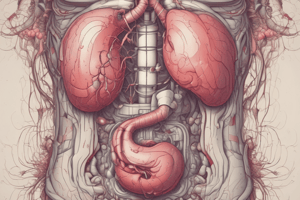Podcast
Questions and Answers
What is characterized as the most serious loss of blood with sudden onset?
What is characterized as the most serious loss of blood with sudden onset?
Upper GIB Patho & Etiology
Which symptoms are indicative of obvious upper gastrointestinal bleeding?
Which symptoms are indicative of obvious upper gastrointestinal bleeding?
- Hematemesis
- Melena
- Both A and B (correct)
- Occult bleeding
What do small amounts of blood in stool or vomit classify as?
What do small amounts of blood in stool or vomit classify as?
Occult Upper GIB
What indicates that arterial bleeding has occurred?
What indicates that arterial bleeding has occurred?
What are considered risk factors for gastrointestinal bleeding?
What are considered risk factors for gastrointestinal bleeding?
What is the primary tool for diagnosing the source of bleeding?
What is the primary tool for diagnosing the source of bleeding?
Angiography is always the first method used to diagnose gastrointestinal bleeding.
Angiography is always the first method used to diagnose gastrointestinal bleeding.
Which of the following tests are included in gastrointestinal bleeding diagnostic studies?
Which of the following tests are included in gastrointestinal bleeding diagnostic studies?
What percentage of patients with massive hemorrhage spontaneously stop bleeding?
What percentage of patients with massive hemorrhage spontaneously stop bleeding?
What types of drug therapy might alter platelet function and clot stabilization?
What types of drug therapy might alter platelet function and clot stabilization?
What is the goal of endoscopic hemostasis therapy?
What is the goal of endoscopic hemostasis therapy?
What immediate assessments should be conducted in GIB emergency management?
What immediate assessments should be conducted in GIB emergency management?
Which interventions are key in GIB emergency management?
Which interventions are key in GIB emergency management?
What should patients and families be taught to prevent future bleeding episodes?
What should patients and families be taught to prevent future bleeding episodes?
Monitoring for signs of shock is an essential component of GIB nursing management.
Monitoring for signs of shock is an essential component of GIB nursing management.
What should be observed if an NG tube is inserted during acute intervention?
What should be observed if an NG tube is inserted during acute intervention?
Chronic alcohol abuse can lead to hemorrhage and requires careful monitoring.
Chronic alcohol abuse can lead to hemorrhage and requires careful monitoring.
What overall goals should be achieved in GIB nursing management?
What overall goals should be achieved in GIB nursing management?
Study Notes
Upper Gastrointestinal Bleeding (GIB)
- Upper gastrointestinal bleeding can present suddenly or as insidious occult bleeding; severity is determined by the origin of the bleed: venous, capillary, or arterial.
Symptoms
- Hematemesis (vomiting blood) and melena (black, tarry stools) indicate obvious upper GIB.
- Occult upper GIB is characterized by small amounts of blood in stool or vomit, often undetected without testing.
Types of Bleeding
- Arterial bleeding presents as profuse, bright red blood, indicating no contact with gastric acids.
- Coffee ground vomitus and melena are also signs of upper GIB; determining the cause can be challenging.
Risk Factors
- Chronic conditions contributing to GIB include chronic gastritis, peptic ulcer disease (PUD), cirrhosis, and history of previous GIB episodes, increasing the risk of recurrence.
Causes of Upper GIB
- Peptic ulcers account for 40% of bleeding cases, commonly linked to H. pylori infection or NSAID use.
- Other causes include gastric cancer, hemorrhagic gastritis, polyps, and stress-related mucosal disease (SRMD).
Diagnostic Tools
- Endoscopy is the primary method for diagnosing the source of bleeding.
- Angiography is used when endoscopy is not feasible but is invasive and may not be suitable for high-risk patients.
- Diagnostic lab studies include CBC, BUN, serum electrolytes, liver enzyme measurements, and analysis of vomitus or stools.
Collaborative Care
- Spontaneous cessation of massive hemorrhage occurs in 80-85% of cases; however, identifying the cause is crucial.
- Documentation of events leading to the bleeding episode is postponed until emergency care is provided.
- Drug therapy may involve H2 receptor blockers, proton pump inhibitors (PPIs), and somatostatin to stabilize clotting.
Endoscopic Hemostasis Therapy
- EGD aims to clot bleeding arteries; it's effective for conditions like gastritis, Mallory-Weiss tears, varices, and bleeding peptic ulcers.
- Techniques include thermal probes for cauterization, injection therapy with epinephrine, and banding for bleeding ulcers.
Emergency Assessment and Management
- Immediate assessment involves monitoring blood pressure, pulse rate and character, peripheral perfusion, and respiratory status, with vital signs checked every 15-30 minutes.
- Abdominal examination occurs once immediate interventions are underway; a complete history regarding previous medical issues and medications is documented.
- Management measures include fluid and blood replacement, supplemental oxygen, and urinary catheter placement for output tracking.
Nursing Management
- Regular monitoring of level of consciousness, vital signs, skin color, capillary refill, abdominal distention, guarding, and signs of shock is essential.
- Goals include cessation of gastrointestinal bleeding, identification and treatment of the underlying cause, restoring hemodynamic stability, and minimizing pain and anxiety.
Patient Education
- Patients should be informed about their disease process, drug therapy, and the importance of avoiding gastric irritants, prescribed medications only, and methods for testing vomitus/stools for occult blood.
- Families are educated on preventing future bleeding episodes and the consequences of noncompliance with diet and medications; smoking and alcohol avoidance are emphasized.
Special Considerations
- Monitor patients with hemorrhage due to chronic alcohol abuse closely for symptoms of delirium tremens, including agitation, shaking, sweating, and vivid hallucinations.
Studying That Suits You
Use AI to generate personalized quizzes and flashcards to suit your learning preferences.
Description
Study the key concepts of Upper Gastrointestinal Bleeding (GIB) with these flashcards. Each card covers important terms, definitions, and characteristics of GIB, including its pathophysiology and clinical manifestations. Enhance your knowledge on this critical medical topic through effective recall practice.



